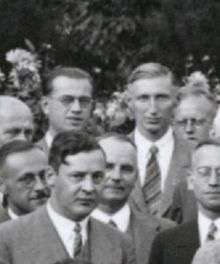Otto Scherzer
| Otto Scherzer | |
|---|---|
|
Above Rudolf Hilsch and Otto Scherzer, in front Erich Hückel, 1935 at Stuttgart | |
| Born |
9 March 1909 Passau |
| Died |
15 November 1982 (aged 73) Darmstadt |
| Nationality | German |
| Occupation | theoretical physicist |
| Known for | Electron microscopy |
Otto Scherzer (9 March 1909 – 15 November 1982) was a German theoretical physicist who made contributions to electron microscopy.
Education
Scherzer studied physics at the Munich Technical University [1] and the Ludwig Maximilians University of Munich (LMU) from 1927 to 1931. At LMU his thesis advisor was Arnold Sommerfeld, and he was granted his doctorate in 1931. His thesis was on the quantum theory of Bremsstrahlung.[2][3] From 1932 to 1933, Scherzer was an assistant to Carl Ramsauer at the Allgemeine Elektrizitäts-Gesellschaft, an electric combine with headquarters in Berlin and Frankfurt-on-Main. There, he did research on electron optics.[4] He completed his Habilitation in 1934, and he then became a Privatdozent at LMU and an assistant to Sommerfeld.[5][6]
Career
In 1935, Scherzer moved to the Technische Hochschule Darmstadt [7] In 1936, he became an extraordinarius professor and director of the theoretical physics department.[8] In a landmark 1936 paper, Scherzer proved that the spherical and chromatic aberrations of a rotationally symmetric, static, space-charge-free, dioptric lens for electron beams cannot be eliminated by skillful design, in contrast to the case for glass lenses.[9] In 1947, Scherzer published a sequel to this paper proposing various corrected lenses, dependent upon abandoning one or other requirements as set forth in the 1936 paper.[10] Scherzer’s derivations contributed to the development of electron microscopy.
From 1939 to 1945, Scherzer worked on radar at the communications research headquarters of the German Navy (Nachrichtenmittel-Versuchskommando der Kriegsmarine).[8] In a communication with Sommerfeld, dated 2 December 1944, Scherzer reported war damage in Darmstadt and commented on his work on radar.[11] From 1944 to 1945, Scherzer was head of radar finding research (Arbeitsbereich Funkmesstechnik) for the Reich Research Council (Reichsforschungsrat),[12] which was the coordinating agency in the Reich Education Ministry (Reichsziehungsministerium) for the centralized planning of basic and applied research.[13]
In 1954, Scherzer became ordinarius professor at the Technische Hochschule Darmstadt, where he helped found the Society for Heavy Ion Research.[8] A literature citation places Scherzer at Darmstadt as late as 1978.[14] Scherzer died in Darmstadt.
Awards
- 1983 – Microscopy Society of America, Distinguished Scientist Award, Physical Sciences[15]
Selected bibliography
- O. Scherzer (Darmstadt) Über einige Fehler von Elektronenlinsen, Zeitschrift für Physik Volume 101, Numbers 9-10, Pages 593-603 (1936). Received 4. Juni 1936.
- O. Scherzer, Sphärische und chromatische Korrektur von Elektronenlinsen, Optik 2 114–132 (1947) as cited in Peter Hawkes - Recent Advances in Electron Optics and Electron Microscopy.
- O. Scherzer (Signal Corps Engineering Laboratories, Fort Monmouth, New Jersey) The Theoretical Resolution Limit of the Electron Microscope, Journal of Applied Physics Volume 20, Issue 1, pp. 20–29 (1948). Received June 14, 1948.
- O. Scherzer, "Limitations for the resolving power of electron microscopes", Proceedings ICEM-9 Volume 3, 123–9 (1978) as cited in Peter Hawkes - The Long Road to Spherical Aberration Correction.
Books
- E. Brüche and O. Scherzer Geometrische Elektronenoptik: Grundlagen und Anwendungen (Springer, 1934)
Notes
- ↑ The Technische Universität München, when Scherzer attended, was known as the Technische Hochschule München.
- ↑ Otto Scherzer – Mathematics Genealogy Project. Dr. phil. Ludwig-Maximilians-Universität München, 1931. Dissertation title: Über die Ausstrahlung bei der Bremsung von Protonen und schnellen Elektronen.
- ↑ Otto Scherzer – Sommerfeld Project: Doctorate for Scherzer, 1931.
- ↑ Hentschel, 1966, Appendix F, p. XLV and Appendix D, p. XII.
- ↑ Sommerfeld Biography – American Philosophical Society
- ↑ Paul Kirkpatrick Address of Recommendation by Professor Paul Kirkpatrick, Chairman of the Committee on Awards, American Journal of Physics 17 (5) 312-314 (1949). In this article, the following students of Arnold Sommerfeld are mentioned: William V. Houston, Karl Bechert, Otto Scherzer, Otto Laporte, Linus Pauling, Carl Eckart, Gregor Wentzel, Peter Debye, and Philip M. Morse.
- ↑ Later known as the Technische Universität Darmstadt after the naming convention change in Germany.
- 1 2 3 Hentschel, 1966, Appendix F, p. XLV.
- ↑ O. Scherzer Über einige Fehler von Elektronenlinsen, Zeitschrift für Physik Volume 101, Numbers 9-10, Pages 593-603 (1936) as cited in Peter Hawkes - The Long Road to Spherical Aberration Correction.
- ↑ O. Scherzer, Sphärische und chromatische Korrektur von Elektronenlinsen, Optik 2 114–132 (1947) as cited in Peter Hawkes - Recent Advances in Electron Optics and Electron Microscopy, and also cited in Peter Hawkes - The Long Road to Spherical Aberration Correction.
- ↑ Personnel Data – Sommerfeld Project
- ↑ The Reich Research Council was formed in March 1937 by Bernhard Rust, a Reich Minister in the Reich Education Ministry. See Hentschel, 1966, Appendix B, p. VII and Appendix F, p. XLIV.
- ↑ Hentschel, 1966, Appendix F, p. XLV, Appendix B, pp. V-VII.
- ↑ Peter Hawkes - The Long Road to Spherical Aberration Correction
- ↑ Otto Scherzer - Microscopy Society of America
References
| Wikimedia Commons has media related to Otto Scherzer (physicist). |
- Klaus Hentschel (editor) and Ann M. Hentschel, (editorial assistant and translator), Physics and National Socialism: An Anthology of Primary Sources (Birkhäuser, 1996)
